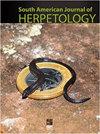Extinction Risk Evaluation and Population Size Estimation of Bothrops insularis (Serpentes: Viperidae), a Critically Endangered Insular Pitviper Species of Brazil
IF 0.7
4区 生物学
Q4 ZOOLOGY
引用次数: 1
Abstract
Abstract. The golden lancehead pitviper (Bothrops insularis) is a critically endangered species endemic to the Queimada Grande Island, a federally protected area located 33 km off the southern coast of São Paulo State, Brazil. Adults have specialized diet, preying upon migrating birds, and the species' reproductive efficiency is quite lower than its continental related species, B. jararaca. Potential threats to B. insularis include illegal removal, introduction of exotic species or diseases, and catastrophic events such as wildfire. The population size of B. insularis was estimated at 2,899 individuals (CI 95% = 1,903; 4,416) in its forested habitat using distance sampling. This is the first population estimation using 3D area model for a reptile habitat. Bothrops insularis was more sensitive to harvesting of few individuals yearly than a catastrophic event that causes mortality over 95% of the entire population in a 100-year simulation period. Prioritizing conservation efforts of reptile species in Brazil depends on simple yet robust monitoring methods like the one presented here. This study was only made possible through the concatenation of government, management, and scientific interests. Such synergism should be encouraged in conservation policies in Brazil, especially in remote locations.巴西极度濒危的岛腹蛛Bothrops islandis的灭绝风险评估和种群规模估计
摘要金枪头皮蝰(Bothrops islandis)是一种极度濒危物种,原产于巴西圣保罗州南部海岸33公里外的联邦保护区Queimada Grande岛。成虫有专门的饮食,捕食候鸟,该物种的繁殖效率远低于其大陆亲缘物种B.jarraca。对岛屿B.islandis的潜在威胁包括非法迁移、引入外来物种或疾病以及野火等灾难性事件。使用距离采样法,岛叶B.islandis在其森林栖息地的种群规模估计为2899只(CI 95%=1903;4416)。这是首次使用爬行动物栖息地的3D区域模型进行种群估计。与在100年的模拟期内导致95%以上人口死亡的灾难性事件相比,岛状肉毒杆菌对每年收获少数个体更为敏感。巴西爬行动物物种的优先保护工作取决于像这里介绍的那种简单而有力的监测方法。这项研究是通过政府、管理和科学利益的结合才得以实现的。巴西的保护政策应鼓励这种协同作用,特别是在偏远地区。
本文章由计算机程序翻译,如有差异,请以英文原文为准。
求助全文
约1分钟内获得全文
求助全文
来源期刊
CiteScore
1.50
自引率
0.00%
发文量
10
期刊介绍:
The South American Journal of Herpetology (SAJH) is an international journal published by the Brazilian Society of Herpetology that aims to provide an effective medium of communication for the international herpetological community. SAJH publishes peer-reviewed original contributions on all subjects related to the biology of amphibians and reptiles, including descriptive, comparative, inferential, and experimental studies and taxa from anywhere in the world, as well as theoretical studies that explore principles and methods.

 求助内容:
求助内容: 应助结果提醒方式:
应助结果提醒方式:


